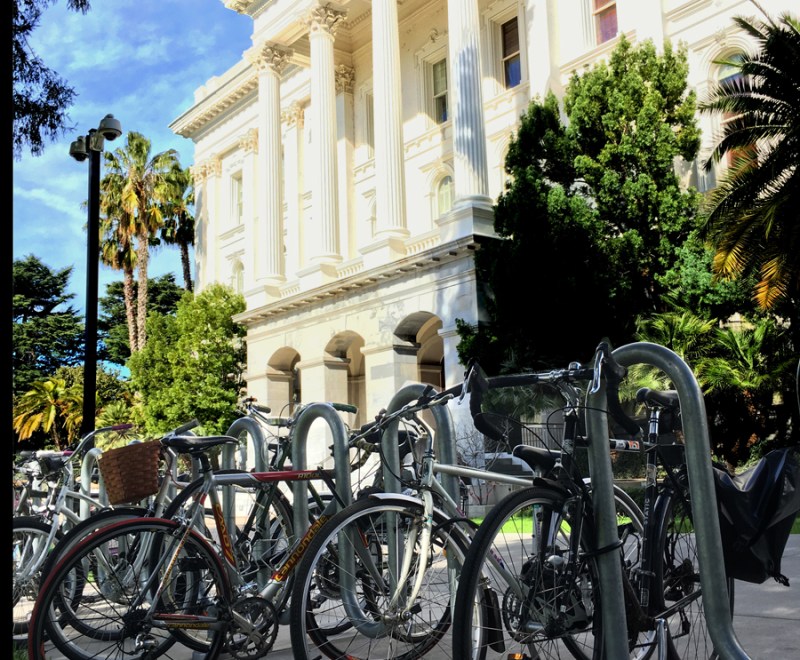Assemblymembers Laura Friedman (D-Glendale) and Phil Ting (D-San Francisco) are having another go at creating a pilot program to test and deploy cameras for automated speed enforcement. A.B. 2336 would allow certain cities to create a five-year pilot program using speed cameras under specific circumstances, and with specific restrictions that attempt to get at the equity concerns underlying opposition to past bills.
Another interesting bill, A.B. 2264 from Richard Bloom (D-Santa Monica), would require the Department of Transportation and local authorities to update all crosswalk signals to include a "Leading Pedestrian Interval," or LPI, which gives people on foot a head start on entering an intersection before vehicles.
The deadline to introduce bills for the 2022 session is tomorrow, and it looks like this year's crop will keep the traffic safety conversation going in the legislature. [So far this session, we've seen bills on jaywalking, stop signs, better planning for bike and pedestrian infrastructure, CEQA exemptions for bike and pedestrian infrastructure, several transit bills - including integrated fares on SF Bay Area transit, free fares for students (two bills), and statewide school transportation - and outlawing freeway expansions in disadvantaged communities.]
Speed enforcement cameras have consistently been shown to improve safety and lower overall speeds on city streets, and they allow enforcement to be applied fairly - in theory. It depends on how and where the cameras are deployed, among other factors.
A.B. 2336 tries to resolve equity concerns by lowering fines and simplifying appeals processes and requiring discounts and diversion programs to be offered in lieu of fines. It also requires cities to work with advocacy groups representing disadvantaged communities on the placement of cameras.
Last year, a similar but somewhat simpler bill, A.B. 550 from Assemblymembers David Chiu (D-San Francisco) and Friedman, died in committee. CalWalks, the statewide pedestrian safety organization, had opposed it, saying that any increased enforcement could create equity issues, since it has become abundantly clear that traffic enforcement disproportionately punishes those who can least afford it.
Caro Jaregui of CalWalks said she has not yet reviewed the language in the new bill, so no word yet as to whether the new provisions resolve their concerns. Note that other pedestrian safety organizations were strongly in favor of last year's bill because of its safety implications.
One interesting aspect of A.B. 2336 is its requirements for continuing the pilot throughout the full five years. That is, if speed cameras do not show that speeding violations are going down by at least 25 percent during the first eighteen months of a program, the city must install a speed feedback sign, letting people know when they are speeding so they can slow down. Simultaneously, the city must begin planning traffic calming measures to reduce speeds in the area. If construction on those measures has not begun within two years, the city must disengage the cameras at the location.
This little provision is powerful; it acknowledges that speed limits and enforcement are not going to stop speeding by themselves, and pushes cities to fix street design that too often privileges car speed over safety by default. Of course, the pilot program is voluntary, and a city could just give up, which is unfortunately what has happened with red light cameras in many cities.
However, the cities currently named as participants in the A.B. 2336 pilot program - Los Angeles, San Francisco, San Jose, and Oakland (and "two as yet unspecified cities") are all cities that are struggling with speeding issues and currently have leaders interested in pursuing better safety measures. That is, they have a stake in making it work. It's assumed that the "two as yet unspecified cities" will be other cities that want to participate as well.
Another provision of the bill comes straight out of the Shoupian playbook: revenues generated by the tickets may be used only to administer the program and to pay for traffic calming measures across the city to make streets safer. (Donald Shoup, the UCLA professor who is changing the way cities think about and supply parking for cars, has long argued that using parking meter revenue to pay for local improvements - and letting the people who pay for parking know where their money is going - is one of the keys to successfully managing city parking.)
To conduct a speed camera pilot, cities would also have to follow specific protocols. These include informing drivers about the program ahead of time, issuing only warnings for the first thirty days, taking only photos of the car's license plate - not the driver - and submitting reports both to their city and to the legislature detailing results from the program, including documenting complaints and describing impacts.
A.B. 2264, from Assemblymember Bloom, would give pedestrians a three- to seven-second head start at all pedestrian signals in California. This safety measure could help lower crashes by letting people on foot get out ahead of cars, where they can be seen, before the vehicles get a green light.
Several studies have shown these head starts are effective at increasing safety, and inexpensive to boot, and some cities - notably Los Angeles and Sacramento, but also likely many more - have already been deploying them. More information, including a link to an explanatory video, can be found at this story from Streetsblog LA.
Note that another bill currently in the hopper - Assemblymember Friedman's Bicycle Omnibus Bill - would also clarify that pedestrian signals apply to cyclists, giving them a similar safety advantage.





